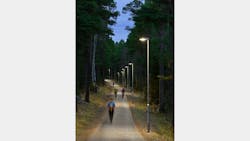Fagerhult buys all of Danish outdoor IoT lighting technology company
Sweden’s Fagerhult Group has acquired full ownership of Danish outdoor lighting control and IoT connectivity specialist Seneco A/S, a company that has been providing technologies to various Fagerhult companies as well as to luminaire makers outside the Fagerhult orbit.
Habo-based Fagerhult last week purchased the remaining 80% of Seneco that it did not already own, having gained a 20% stake in 2017. The company declined to reveal the purchase price.
Fagerhult CEO Bodil Sonesson told LEDs Magazine that Seneco’s management team will remain intact and will “start to work more closely” with the IoT development group at Fagerhult, which is based at Fagerhult’s new “competence center” in Linkoping, Sweden.
The Linkoping site also houses development of Fagerhult’s Organic Response wireless indoor IoT connectivity, which is part of OR Technologies, a Fagerhult company based in Melbourne, Australia.
The move could well lead to wider adoption of Seneco technologies across Fagerhult Group’s twelve luminaire brands. Of those, Fagerhult, WE-EF, ateljé Lyktan, and iGuzzini have already built Seneco into their wares.
Fagerhult will also carry on supplying the Seneco technologies to non-Fagerhult luminaire vendors, Sonesson told LEDs. Those users include Italy’s Cariboni Group, Denmark’s Focus-Lighting, and Sweden’s PrismaTibro.
“Seneco will continue to support luminaire manufacturers outside the Fagerhult Group,” Sonesson said. “It is important for us to continue to service the municipalities using the Seneco technology today.”
The Seneco stable includes controllers, motion sensors, communications chips, gateways, and cloud management software with a dashboard control. Seneco-enabled luminaires are designed to be commissioned with an app. The company has a patent pending on proprietary technology for passive infrared (PIR) motion detection and on wireless communication in the sub-GHz range that is based on open standards for mesh networking between luminaires, Sonesson said.
Seneco sells both to luminaire makers and to Zhaga socket makers, for use in connected street lighting and urban lighting and landscaping in public spaces such as parks. It has outfitted a number of cycling tracks and jogging tracks in Denmark, for instance, with sensors that brighten dimmed lights as people approach.
Sonesson told LEDs that Fagerhult is undecided on whether to back the TALQ Consortium, a group which aims to certify interoperability of smart LED street lights by ensuring that central management software and gateways from different vendors are compatible with one another.
“We are continuously monitoring and considering the evolution of various standards in the market (indoor and outdoor) such as TALQ 2.0,” Sonesson said.
For indoor IoT connectivity, Fagerhult uses Organic Response. It has been known to weave Organic Response into a network using a mesh protocol from Finland’s Wirepas, such as in an installation at the Medicon Village life sciences research park in Lund, Sweden, in partnership with security firm Securitas.
MARK HALPER is a contributing editor for LEDs Magazine, and an energy, technology, and business journalist ([email protected]om).
For up-to-the-minute LED and SSL updates, why not follow us on Twitter? You’ll find curated content and commentary, as well as information on industry events, webcasts, and surveys on our LinkedIn Company Page and our Facebook page.

Mark Halper | Contributing Editor, LEDs Magazine, and Business/Energy/Technology Journalist
Mark Halper is a freelance business, technology, and science journalist who covers everything from media moguls to subatomic particles. Halper has written from locations around the world for TIME Magazine, Fortune, Forbes, the New York Times, the Financial Times, the Guardian, CBS, Wired, and many others. A US citizen living in Britain, he cut his journalism teeth cutting and pasting copy for an English-language daily newspaper in Mexico City. Halper has a BA in history from Cornell University.





